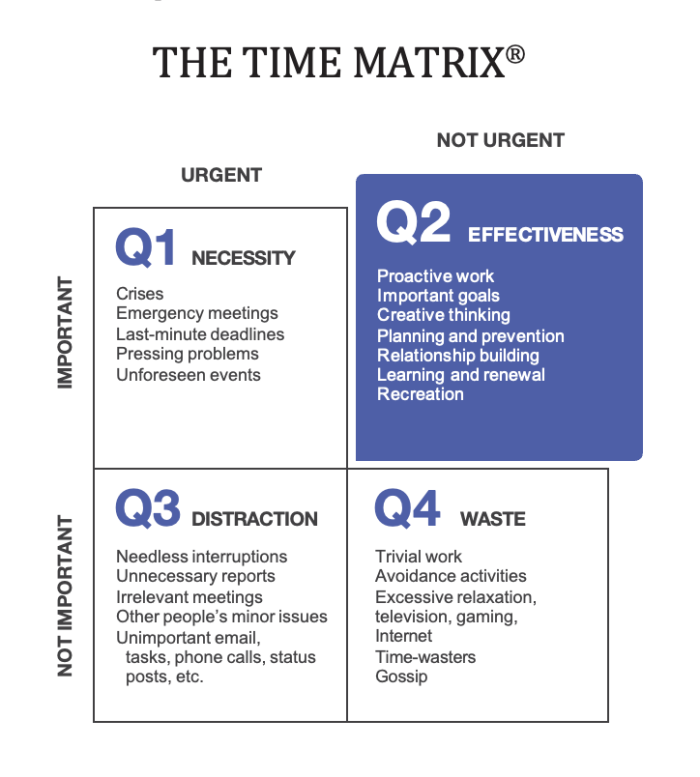5 Ways to Narrow Your Sales Focus in Times of Uncertainty

- 1. Focus Less on Pockets of Great Performance and More on Consistent Execution
- 2. Focus Less on the Big Number and More on the Little Number
- 3. Focus Less on the Lag Measure and More on the Lead Measure
- 4. Focus Less on Broad Skills and More on What Will Move the Lead Measure
- 5. Focus Less on Internal Tasks and More on Your Team and Customers
Even in the best of times, sales leaders hardly ever hit their sales targets quarter after quarter and year after year. In fact, more than 84% of sales reps in 2024 missed their targets the previous year, according to Salesforce.
Now, in the midst of growing uncertainty, hitting the number has become exponentially more difficult. And it may even appear impossible.
Most of us probably began the year with optimism and a strong strategy to hit our targets. But a lot has changed since then, and your company and team members are looking to you for results. Here’s the hard truth: No matter how difficult the situation, some people and organizations in your industry will not only hit their targets but also exceed them. It might as well be you.
Download our free guide, The Agility Advantage: 4 Steps to Respond to Change and Achieve Consistent Business Results, to align your teams and respond with agility during uncertain times.
Let’s assume for a moment that your original target is no longer achievable, your plan is no longer relevant, your team is distracted, the economy has stalled, and your customers are on pause. So, what will successful sales leaders do that the rest of us won’t?
The answer: They will focus on less. Through many thousands of client engagements, FranklinCovey has proven that sales leaders are far more likely to achieve their targeted sales results when they narrow their focus.
But everyone already knows that, at least in theory. So why won’t they achieve great results during this challenging time? Because they’re focusing on the wrong things. Here’s what to do instead:
1. Focus Less on Pockets of Great Performance and More on Consistent Execution
By pockets of great performance, I mean great sales teams, top-performing salespeople, best-in-class leaders, etc. In every organization, some people simply accomplish more great things and get the desired results. It’s tempting to focus solely on these pockets to survive during a crisis, but you do so at the risk of consistent execution.
The market cares about consistent execution more than anything else. Without it, your customers, employees, and shareholders will not trust you. Keeping your commitments makes the difference between success and failure. When goals or strategies falter, leaders tend to change direction. The problem, however, is usually not with the strategy, but with inconsistent execution of the strategy.
At the core, execution of a new goal means people must change their behavior and habits—and the behavior that enabled the execution of goals several months ago will no longer suffice. Successful sales leaders focus less on the high-performing pockets and make it their mission to move the middle—the underperforming pockets—to consistently execute like the pockets of great performance.
Moving the middle, or getting “righter and tighter” on the performance curve, requires changing human behavior. And changing behavior is hard: When was the last time you tried to change one of your own habits? To eat less, cut down on social media scrolling, or exercise more? That’s nothing compared to trying to change the behavior of other people. Have you ever tried to change the habits of your spouse or partner? If changing your own behavior is hard and changing someone else’s is even harder, how about changing the behavior of a whole lot of people in your organization all at once?
New goals you have never achieved before will require new behaviors you have never done before.
Download our free guide, Impact Your Organization’s Results: Turn Your Average Employees Into High Performers, to learn how to “move your middle” and drive results.
2. Focus Less on the Big Number and More on the Little Number
Most businesses have some momentum in terms of revenue—revenue that will be generated if nothing is done differently or if no one did any additional work from here on out. I call this “lights-out revenue.”
A sales leader’s role isn’t to hit the lights-out revenue. Their role is to hit the difference between the lights-out revenue and the revenue target. Let’s call this number “the gap.”
During “normal” times, lights-out revenue is usually between 50% and 80% of an annual revenue target, depending on industry and product or service. In periods of uncertainty, this momentum gets turned on its head. The first trick to hitting your number is calculating the new gap that has emerged as a result of a change or period of uncertainty.
I recommend a collaborative top-down and bottom-up approach. Often in times of crisis or transformation, decision-making is centralized, collaboration is shut down, and “command-and-control” leadership becomes the new status quo. Resist this urge. As the leader, look at the gap from the top by examining the current situation with revenue, customers, sales productivity, and any other data points that are relevant to your team. What new lights-out number are you confident in? What is the new gap? It may seem unachievable at this moment. That’s okay for now. It’s a place to start.
Now for the bottom-up portion of this exercise. Share your thinking and the new gap with your entire team. It’s critical that your team is engaged in this work effort. Over the next few days, have your team work independently to complete the same exercise. Make sure no one is pressured into inflating the new lights-out number. Keep an open mind and reward transparency.
The Most Trusted Leadership Company
Learn how your organization can use our people, content, and technology to create collective action and meaningful change.

3. Focus Less on the Lag Measure and More on the Lead Measure
Now that you’ve established the gap, how do you close it? Many leaders focus too heavily on the gap itself, when the gap is a lag measure—meaning, by the time you see the result, the performance that drove it has already happened.
Most sales organizations I’ve worked with have an overabundance of reporting around what happened—prior-period sales by customer, product, rep, team, and so on. Pipeline reports are sliced this way and that way and then weighted to arrive at a prediction of the future. Management often pores over these reports and invests countless hours in calls and meetings to review them. All the while, none of this data helps close the gap.
Top-performing sales leaders understand this, so they spend less time on lag data and more time on the lead measures that produce the desired results. Lead measures are both predictive, meaning they lead to the accomplishment of the lag measure or goal are influenceable, meaning you can do something about them. Focusing on lead measures means narrowing your focus to the two or three actions that “lead” to the lag measure, or the result.
Often, I hear leaders say, “I understand lead measures. We need more proposals and pipeline. Got it.” Well, no: Proposals and pipeline are lag measures. Sure, they may be predictive of results, but they are not very influenceable.
When deciding on the right lead measure for proposals or pipeline, the question to ask is: What behavior leads to more proposals? In our organization, we know that more high-quality time with both current clients and new prospects leads to more high-quality proposals. Face-to-face (Zoom or equivalent) time is our lead measure, and we focus on scoreboards, reports, and meetings that relate to it.
4. Focus Less on Broad Skills and More on What Will Move the Lead Measure
No matter how capable or experienced, your salespeople can get better—much better—at the selling skills needed to move the lead measure.
Notice the nuance here: “Move the lead measure.” Most training is done very broadly, and everyone is trained on the same thing. But that’s a mistake.
Let’s work with face time as the lead measure. What skills would someone need to excel at this lead measure so that your clients and prospects would rave about the time spent and even refer you to new prospects? Which of your team members need to improve those skills? Or imagine you were meeting with a group of clients and prospects, and you asked them to design an ideal meeting with a sales team—one that would be immensely valuable to them. What would they design?
I have asked, and here’s what they don’t want: your company story, your perspective on the industry, your product or service overview, a game of 20 questions, or efforts to develop rapport. What they do want is help and expertise in addressing important and pressing issues in their business. This is more important now than ever. Now, what skills would your salespeople need to excel at to create this kind of meeting? Let’s say that they would need to have deep domain expertise and excellent problem-solving skills. These skills, when expertly applied, would create high-quality face time with clients and prospects, lead to meaningful proposals, create more pipeline, and result in closing the gap.
To become truly expert at these skills requires more than training. Application and practice make the difference. Set aside dedicated time each week to practice and hone these skills.
Are your sales teams focused on the right activities? Download our free 80/20 Activity Analyzer tool to reveal the most impactful behaviors for outstanding results.
5. Focus Less on Internal Tasks and More on Your Team and Customers
Look at your calendar. Mark the number of times in the past month that you met with a customer or spent quality time with your frontline salespeople. If you’re like most sales leaders, the number is simply too low. Your days are filled with meetings, calls, texts, and emails, all focused on urgent internal tasks. FranklinCovey refers to these as Quadrant 1 tasks, and we know they still need your attention. They are important and urgent but rarely lead to closing your sales gap and hitting the goal.

Gap-closing activities live in Quadrant 2—the important but not urgent tasks. That’s also where lead measures live. In Quadrant 2, you learn what’s working and what needs to change with your team. You see firsthand the level of expertise your team members have.
After a week in Quadrant 1, it often seems like nothing has been done, whereas a few hours in Quadrant 2 almost always visibly move you ahead. Prioritize your Quadrant 2 time with your team. Coaching, planning, skill development, practicing, and preparing for client meetings are all examples of Quadrant 2 activities.
I commonly see sales plans presented as narrow and focused, only to uncover numerous sub-goals, programs, projects, and initiatives. We’ve been conditioned to reject things that are simple and easy to explain, viewing them as simplistic, lazy, or incomplete, when the opposite is true.
Chris McChesney, the lead author of the bestselling book The 4 Disciplines of Execution, said: “There will always be more good ideas than there is capacity to execute.” Focusing on less is exactly what is required to win during periods of uncertainty and to be counted among the few successful sales leaders who emerge stronger. This is your moment to shine.
Download our free guide, How to Sell in Times of Uncertainty, to access our 2025 action plan for sales professionals facing change and disruption.








